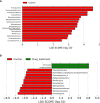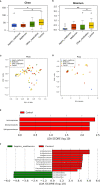Characterization of Vaginal Microbiota in Women With Recurrent Spontaneous Abortion That Can Be Modified by Drug Treatment
- PMID: 34490136
- PMCID: PMC8417370
- DOI: 10.3389/fcimb.2021.680643
Characterization of Vaginal Microbiota in Women With Recurrent Spontaneous Abortion That Can Be Modified by Drug Treatment
Abstract
Objective: The role of vaginal microbiota in recurrent spontaneous abortion (RSA) remains unknown. The purpose of this study was to investigate characteristics of vaginal microbiota and the effects of drug treatment on vaginal microbiota of patients with RSA.
Methods: A case-control study was performed, in which non-pregnant patients who experienced RSA were selected and divided into untreated and drug-treated groups. Drug-treated patients were subdivided into the metformin group, metformin plus aspirin group, and other drugs group. Healthy women who had live births and never experienced spontaneous abortion were enrolled in the control group. Characteristics of vaginal microbiomes of patients with RSA and healthy women and the impact of drug treatment on the microbiome was evaluated via 16S rRNA gene sequencing of the V3-V4 region using the Illumina MiSeq platform.
Results: Women who underwent RSA had lower microbial richness than healthy women. Compared to controls, the relative abundance of seven taxa (Megasphaera, Sneathia sanguinegens, Pseudomonas, Sphingomonas, Rhodococcus, Burkholderia- Caballeronia-Paraburkholderia, and Corynebacterium_1) in the patient's vaginal microbiota changed significantly, which may be closely related to RSA. The composition of the vaginal microbial community in RSA patients was altered by drug treatment. Metformin combined with aspirin treatment significantly increased the relative abundance of vaginal Lactobacillus spp. in patients.
Conclusion: An altered vaginal microbiome composition might be associated with RSA, which could be modified by drug treatment. The effect of metformin combined with aspirin on vaginal Lactobacillus is worthy of attention.
Keywords: 16S rRNA gene; RSA; aspirin; metformin; recurrent spontaneous abortion; vaginal microbiome.
Copyright © 2021 Zhao, Chen, Gao, Wu, Li, Wang, Huang, Cui, Du and Ying.
Conflict of interest statement
NH and LC were employed by the company Sinotech Genome Technology Co., Ltd. The remaining authors declare that the research was conducted in the absence of any commercial or financial relationships that could be construed as a potential conflict of interest.
Figures





Similar articles
-
The Vaginal Microbial Signatures of Preterm Birth Delivery in Indian Women.Front Cell Infect Microbiol. 2021 May 13;11:622474. doi: 10.3389/fcimb.2021.622474. eCollection 2021. Front Cell Infect Microbiol. 2021. PMID: 34094994 Free PMC article.
-
An Altered Microbiota in the Lower and Upper Female Reproductive Tract of Women with Recurrent Spontaneous Abortion.Microbiol Spectr. 2022 Jun 29;10(3):e0046222. doi: 10.1128/spectrum.00462-22. Epub 2022 May 23. Microbiol Spectr. 2022. PMID: 35604131 Free PMC article.
-
Is there an association between the vaginal microbiome and first trimester miscarriage? A prospective observational study.J Obstet Gynaecol Res. 2022 Jan;48(1):119-128. doi: 10.1111/jog.15086. Epub 2021 Nov 10. J Obstet Gynaecol Res. 2022. PMID: 34761471
-
Microbiome structure in healthy and pregnant women and importance of vaginal dysbiosis in spontaneous abortion.Front Cell Infect Microbiol. 2025 Feb 17;14:1401610. doi: 10.3389/fcimb.2024.1401610. eCollection 2024. Front Cell Infect Microbiol. 2025. PMID: 40046910 Free PMC article. Review.
-
Female reproductive tract microbiome and early miscarriages.APMIS. 2023 Feb;131(2):61-76. doi: 10.1111/apm.13288. Epub 2023 Jan 2. APMIS. 2023. PMID: 36511842 Free PMC article. Review.
Cited by
-
Nanopore-based metagenomics analysis reveals microbial presence in amniotic fluid: A prospective study.Heliyon. 2024 Mar 19;10(6):e28163. doi: 10.1016/j.heliyon.2024.e28163. eCollection 2024 Mar 30. Heliyon. 2024. PMID: 38545162 Free PMC article.
-
Association between vaginal microbiome alteration and povidone iodine use during delivery.BMC Microbiol. 2023 Nov 17;23(1):348. doi: 10.1186/s12866-023-03014-5. BMC Microbiol. 2023. PMID: 37978422 Free PMC article.
-
Clinical Relevance of Vaginal and Endometrial Microbiome Investigation in Women with Repeated Implantation Failure and Recurrent Pregnancy Loss.Int J Mol Sci. 2024 Jan 3;25(1):622. doi: 10.3390/ijms25010622. Int J Mol Sci. 2024. PMID: 38203793 Free PMC article. Review.
-
Intratumor Rhodococcus sp. B513 drives DEN-induced hepatocellular carcinoma progression by modulating gut microbiota and angiogenesis.Curr Res Microb Sci. 2025 Jun 24;9:100428. doi: 10.1016/j.crmicr.2025.100428. eCollection 2025. Curr Res Microb Sci. 2025. PMID: 40686840 Free PMC article.
-
Vaginal Microbiome in Pregnant Women with and without Short Cervix.Nutrients. 2023 May 2;15(9):2173. doi: 10.3390/nu15092173. Nutrients. 2023. PMID: 37432374 Free PMC article.
References
Publication types
MeSH terms
Substances
Supplementary concepts
LinkOut - more resources
Full Text Sources
Medical
Miscellaneous

